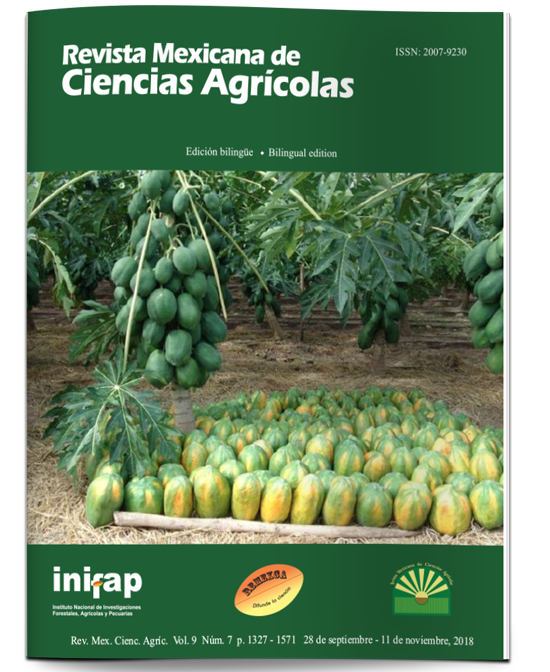Estimation of maize genetic parameters under improvement by recurrent reciprocal selection
DOI:
https://doi.org/10.29312/remexca.v9i7.1668Keywords:
heritability, trilinear maize hybrids, additive genetic variabilityAbstract
In the development of trilineal corn hybrids it is required to know the genetic parameters of the populations that are used to derive their parent lines. In this study, the additive variance was estimated directly from the genotype component of the Anova in the random evaluation of 182 S1 lines derived from the ‘P’ population (producers). This participates in a heterotic pattern P x A (farmers) in continuous improvement through the method of reciprocal recurrent selection (SRR). In 2014 the lines were evaluated in Xalisco, Compostela and Santa Maria del Oro, Nayarit. The combined Anova detected significant differences between the lines for most of the variables studied. High estimates of additive variance resulted for grain yield and other agronomic characteristics. High estimates of heritability in the strict sense were observed due to high estimates of additive variance. The grain yield showed a high heritability of 0.63, similar to most of the estimates studied in corn. A high heritability was observed in all the characters of the performance components. Heritability estimates varied from 0.54 to 0.87 and are in the similar ranges that have been observed in most studies conducted in corn. The values are adequate to have progress in the evaluated characters of the population P; which will allow for the case of the development of trilinear hybrids to find simple intra-cross combinations that can be used as simple female crosses in the production of grain and seed.
Downloads
Downloads
Published
How to Cite
Issue
Section
License
The authors who publish in Revista Mexicana de Ciencias Agrícolas accept the following conditions:
In accordance with copyright laws, Revista Mexicana de Ciencias Agrícolas recognizes and respects the authors’ moral right and ownership of property rights which will be transferred to the journal for dissemination in open access. Invariably, all the authors have to sign a letter of transfer of property rights and of originality of the article to Instituto Nacional de Investigaciones Forestales, Agrícolas y Pecuarias (INIFAP) [National Institute of Forestry, Agricultural and Livestock Research]. The author(s) must pay a fee for the reception of articles before proceeding to editorial review.
All the texts published by Revista Mexicana de Ciencias Agrícolas —with no exception— are distributed under a Creative Commons License Attribution-NonCommercial 4.0 International (CC BY-NC 4.0), which allows third parties to use the publication as long as the work’s authorship and its first publication in this journal are mentioned.
The author(s) can enter into independent and additional contractual agreements for the nonexclusive distribution of the version of the article published in Revista Mexicana de Ciencias Agrícolas (for example include it into an institutional repository or publish it in a book) as long as it is clearly and explicitly indicated that the work was published for the first time in Revista Mexicana de Ciencias Agrícolas.
For all the above, the authors shall send the Letter-transfer of Property Rights for the first publication duly filled in and signed by the author(s). This form must be sent as a PDF file to: revista_atm@yahoo.com.mx; cienciasagricola@inifap.gob.mx; remexca2017@gmail.
This work is licensed under a Creative Commons Attribution-Noncommercial 4.0 International license.



